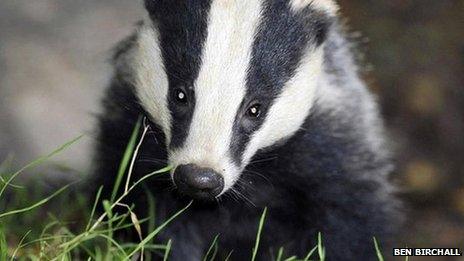Benefits and risks of badger cull extension
- Published

The government set itself the target of culling 70% of badgers over six weeks
Environment Secretary Owen Paterson and the chief vet Nigel Gibbens have been explaining why they extended the pilot badger culls in Somerset and Gloucestershire. BBC science correspondent Pallab Ghosh examines the reasons for the extension.
The Department for Environment Food and Rural Affairs (Defra) set itself the target of culling an average of 70% of badgers within the pilot cull areas over a six-week period, sustained for four years. Indeed, these were the terms of the licence granted by Natural England for the culls.
The companies charged with culling the badgers have fallen short of the target, reducing populations by 60% in west Somerset and 30% in west Gloucestershire. Mr Gibbens's advice was to carry on culling in both areas to control the spread of the disease.
On the face of it that might make sense to some. Surely if there are fewer badgers then the risk of TB in cattle is lowered? And what is wrong with going beyond the six week period to do so?
A spokesperson from Defra's press office told BBC News that the six-week culling period was arbitrary.
"Six weeks was set as the cull period by wildlife experts," he said. "It is not based on scientific evidence so it's impossible to say culling beyond six weeks necessarily increases perturbation - it's a theory but not conclusive," the spokesperson said.
Scientists involved with the original Randomised Badger Culling Trial (RBCT), on which the strategy for the current pilot culls are based, take issue with this interpretation.
Their concern arises from the data they obtained from the RBCT, which was carried out between 1998 and 2005 to assess the effectiveness of badger culling.
The RBCT mostly involved a series of short, sharp culls carried out over a period of two weeks in TB hot spots. There were, however, four trials that were carried out over a longer period.
The researchers found that after the first cull, TB infection in badgers increased the following year because of the increased movement of badgers (perturbation). They found that there was a bigger increase in areas where the culling was prolonged.
A number of expert panels, including Defra's own Science Advisory Council and TB group, concluded that a modest reduction in TB in cattle could be obtained if the culls were short, sharp and carried out each year for four years.
The group suggested in 2010 that 70% of badgers should be killed in a large area over a period of between four and six weeks.
There was evidence from the RBCT that culling beyond two weeks might cause problems, but a figure of four to six was chosen because it was judged it would be impractical to kill that many badgers within two weeks in a large area. It was however generally accepted that the longer the cull went on, the less likely that TB infection would be reduced.
In making a judgment to extend the culls in Gloucestershire and Somerset, Mr Gibbens considered two competing factors.
On one hand, continuing the cull would reduce the badger population. Yet on the other, it would also increase the movement by badgers and so spread infection in the population. Mr Gibbens made the judgment that continuing was, on balance, the preferable option.
A Defra spokesperson said: "The RBCT found that an average 70% reduction over four years resulted in a disease reduction. It did not stipulate the length of time in which culling needed to be carried out, or at what level of population decrease disease benefits begin to accrue. That is a key part of Nigel's advice that the more badgers you remove, the greater the benefits."
But critics of the policy argue there is no evidence for how the two competing factors could play out.
Prof Rosie Woodroffe, who was involved with the RBCT already had concerns about expanding the culling period from two weeks to six.
"Going from six to 14 weeks (as they have in the Gloucestershire cull area) is uncharted territory," she told BBC News.
"It is not unreasonable to expect that as you prolong the cull and you prolong increased badger movement, you increase the detrimental effects."
There is also an additional concern for Defra. A piece of research for the department carried out by Prof Christl Donnelly indicated that culling in the winter months increased infection in the badger population still further.
Follow Pallab on Twitter, external
- Published28 October 2013
- Published29 October 2013
- Published28 September 2012